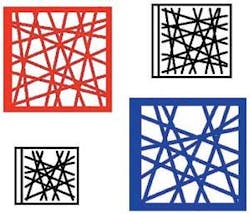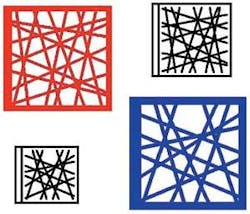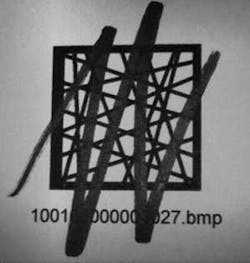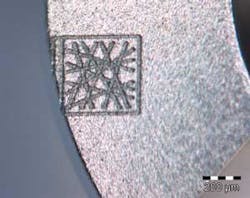A dynamic 2D laser mark
A new type of mark offers counterfeit blocking, extreme miniaturization capabilities, and greater damage resistance
David Clark and Kevin Simmons
One- and two-dimensional barcodes have become ubiquitous tools for informational marking on a truly staggering array of products and objects. These marks can be printed on a label or directly applied to the product with printing or laser marking. However, traditional barcodes have limited utility in certain areas, such as blocking product counterfeiting, preventing outsider access, code miniaturization, and robust information content that persists even with physical defacement of the mark.
In a conventional linear barcode, the information is coded as alternating dark and light lines of varying thickness and spacing. In a two-dimensional barcode, the information is coded in an array of dark and light square pixels. The new 2DMI code is completely different; a computer algorithm converts the binary or alphanumeric information into a rectangular (or square) pattern of intersecting lines (see Figure 1). The position, angle, and thickness of these lines all combine to carry the coded information. Several levels of mark complexity have been developed, with different numbers of lines, supporting up to 15 digits of information.
Among the advantages of this approach is a relative immunity to information loss through damage. If part of a traditional barcode is obliterated, then that segment of the coded information is permanently lost. But with 2DMI, as long as just some part of every line can be imaged by the reader, then the system software can readily reconstruct the entire image and thereby decode all the original information. In fact, an entire corner or most of a side of the 2DMI mark can be obliterated without any loss of information (see Figure 2). This is particularly useful in multiple-use and/or high-wear products.
Another major advantage of 2DMI is proprietary coding. The coding of conventional barcodes is standardized, and can be read and duplicated by anyone in order to create them on counterfeit products. Not so with 2DMI. Complex proprietary encryption algorithms are used to generate and de-code the marks. Moreover, these algorithms support almost infinite combinations of coding. Each licensed user of 2DMI is supplied with their own completely unique encryption algorithm, providing them with a secure closed system. Anyone not equipped with that user’s algorithm can neither read nor copy those codes-even if they have their own 2DMI system supplied by Orbid. This protects the user from product counterfeiting and hinders the activities of unscrupulous distributors, such as illegal discounting or trans-shipments.
Finally, there is a limit to how small conventional barcodes can be generated and read-the pixels and lines are close together and need to be a minimum size. In contrast, 2DMI is a relatively open mark with well-spaced lines and thus doesn’t require the resolution or contrast of a conventional mark. This allows the 2DMI mark to be used in a much smaller format. In the case of small high-value items such as wristwatches, jewelry, or gemstones, the mark can be generated using a Q-switched ultraviolet laser, for maximum spatial resolution. The mark can be a fraction of a millimeter in size and thus completely unobtrusive.
How is 2DMI marking implemented in practice? In some cases, customers have engaged Orbid by establishing an Application Engineering Agreement that outlines the exact deliverables Orbid needs to achieve before the client licenses the technology. Part of this agreement could include the delivery of product samples and application design specifications. In cases where anti-counterfeit protection is an important benefit, a series of genuine and counterfeit marks can be produced to prove that the Orbid system can clearly distinguish between the two. Purchase of the system requires a license fee and a per-use fee based on the number of products being marked. Small volume customers generally have their parts marked by a laser system that might be outsourced by the end customer. Higher volume customers purchase a third-party laser marking workstation in close cooperation with Orbid. Marks are read by conventional handheld imaging-type scanners and the information is decoded in a system computer equipped with the appropriate algorithms.
Titanium medical implants
Stryker Leibinger GmbH (Freiburg, Germany), a division of Stryker, has implemented 2DMI marking to prevent counterfeiting of its products. Stryker Leibinger Micro Implants, one of the leading names in metal medical implants, specializes in small screws and plates that are used to repair fractures of the mid-face, mandible, and hand, for both neurological and reconstructive purposes. Explains Andreas Ippisch, project engineer, research & development, “Our products are used to repair tiny bones following trauma and are used in small delicate operations. In fact the biggest screw we make is only 3.2 mm x 42 mm. And some of our screws are only 1 mm in diameter with a 1.8 mm diameter head and 2mm length. Our products are made from either pure titanium or titanium alloy.”
At first glance, this may seem to be an unlikely product-type for counterfeiting. However, these are high value products and the company has experienced problems with copies of inferior material in the marketplace. Clearly it is not in the interest of the patient or Stryker for these unregulated copies to make their way into critical surgeries. Furthermore, the FDA requires that, if the technology is available, implant suppliers implement a product traceability system that allows product tracking from initial fabrication all the way to the patient. There is also the issue of trans-shipment where distributors may illegally divert products intended for one country to another country in order to avoid or reduce import duties and other fees.
Stryker utilizes a 2DMI marking system based on an all solid-state, ultraviolet laser (Coherent Avia). This source provides the required spatial resolution and power for making small marks in titanium. They are using Image Team 4600 PDF handheld readers to read the marks. The company plans to use 2DMI to now mark every individual component with up to 12 bits of information.
The 2DMI system satisfies Stryker’s goal of marking even the tiniest of screws with a proprietary system mark that can only be read by Stryker personnel, licensed agents, and customers. Ippisch explains that, “Mark miniaturization is the key for our application. On a screw head as small as 1.8 mm diameter, when you allow for the size of the slots or driving notches, there is very little room left for a mark. Yet with 2DMI and a UV laser, we can code 15 digits of information into a mark that is between 250 and 350 microns square (see Figure 3). And because we have a unique coding algorithm supplied by Orbid, no-one but Stryker and our associates can read the code or produce counterfeit products that appear as though they were made by our company.”
Marking stainless-steel beer kegs
Trumer Brauerei, producer of Trumer Pils, an authentic European pilsner originating in Austria and brewed in Berkeley, CA, recently adopted 2DMI marking for its stainless-steel kegs because of the mark’s durability and resistance to damage. Master Brewer Lars Larson explains, “The typical beer keg has an expected lifetime of 20 to 30 years. It may be filled between two and 10 times a year depending on the market, with seal changes performed after roughly every 10 fills. These beer kegs have a rough and long life, accumulating lots of scratches and dings over that lifetime. We are hoping that the 2DMI system will stand up to this abuse and ultimately allow us to track, trace, and inventory every one of our kegs. All tests so far indicate that this will be successful. The biggest challenge so far is in optimizing the scanning process. Should this technology prove itself at our brewery, there are implications for use at the other breweries within our organization, which carry larger keg fleets than Trumer.”
To date Trumer has marked about half their total of several thousand kegs (see Figure 4). These are marked on both the top and bottom surface. Several different sized marks were tested for readability, with the final choice measuring just less than 19 mm. Both the top and bottom surfaces must be marked because beer kegs are cleaned and filled upside down. Having a mark on the lower surface has allowed Trumer to integrate an automatic recording system that logs the kegs as they leave the filling station. The kegs are then stacked upright on pallets. They are then scanned at shipping using a handheld scanner on the top surface. And finally, returned kegs are manually scanned upon return to the brewery, before any cleaning is performed.
In conclusion, the applications for laser marking continue to grow and diversify. The development of a new type of two-dimensional mark will add considerable value and integrity over both the traditional barcode and alphanumeric-type marks for many diverse products. At the same time, continued advances in solid-state lasers, especially with output in the UV, means that these benefits can be realized without adding undue cost to the marked products.
David Clark ([email protected]) is with Coherent Inc. and Kevin Simmons ([email protected]) is with Orbid Corp.




